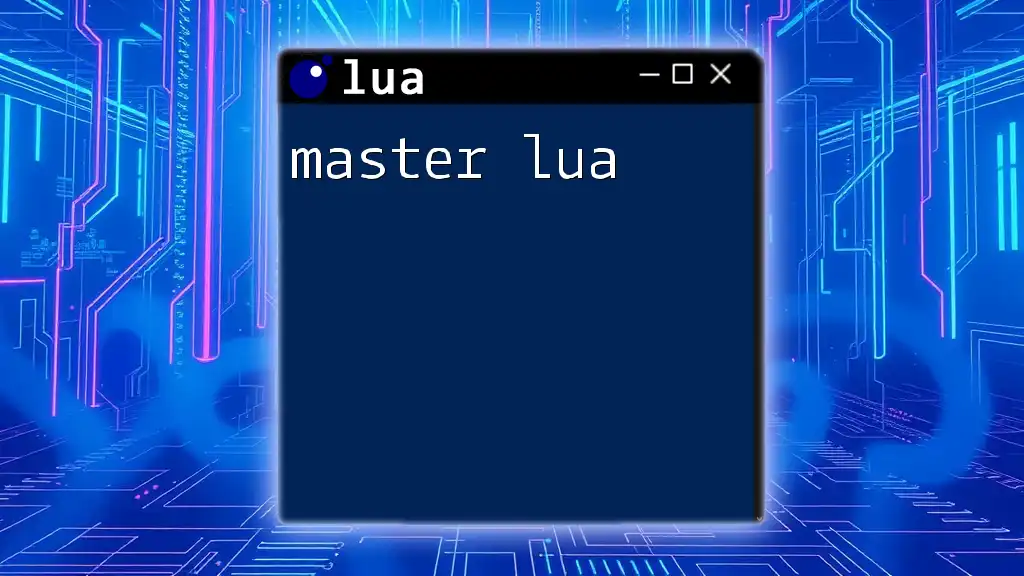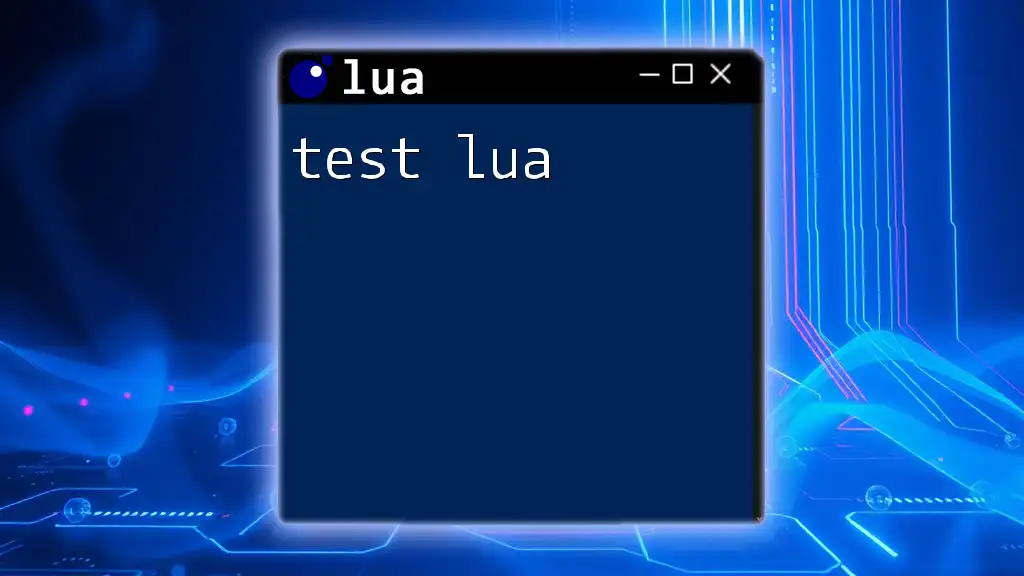"Testing Lua involves executing simple scripts to verify functionality, such as printing a message to the console."
Here’s a basic example of a Lua script that tests output:
print("Hello, Lua!")
Understanding Lua Testing Basics
What is Testing in Lua?
Testing in programming refers to the process of evaluating the functionality of code to ensure that it operates as expected. In the context of Lua, it means verifying individual Lua commands, functions, and modules to catch errors, bugs, and unexpected behavior early in the development process. This practice is crucial for maintaining code quality, especially when working on larger projects or when collaborating with a team.
Benefits of Testing Lua Code
Testing Lua code brings numerous advantages that can enhance your development journey:
- Reliability and Stability: Running tests helps identify problems before they reach production, ensuring your Lua code behaves reliably.
- Early Bug Detection: By implementing tests during development, you can catch bugs early, which is less costly than resolving them after deployment.
- Supports Code Refactoring: Tests act as a safety net when refactoring your code. They help ensure existing functionality remains intact while making improvements.

Setting Up Your Lua Testing Environment
Installing Lua
To begin testing Lua code, you first need to install the Lua interpreter. Here’s a brief overview of how to set it up on various platforms:
- Windows: Download the installer from the [official Lua website](https://www.lua.org/download.html) and follow the instructions to complete the installation.
- macOS: Use Homebrew for a quick installation by running the following command in your terminal:
brew install lua - Linux: Most distributions allow you to install Lua through the package manager. For example, on Ubuntu, execute:
sudo apt-get install lua5.3
Choosing a Lua Testing Framework
Several testing frameworks can enhance your Lua coding experience. Here are some popular options:
- LuaUnit: A simple unit testing framework that's easy to use for beginners.
- Busted: A behavior-driven development (BDD) framework that supports more complex testing requirements.
Each framework has its strengths and weaknesses. For a straightforward start, consider LuaUnit. You can install LuaUnit by following these commands after installing Lua:
luarocks install luaunit

Writing Your First Test in Lua
Structuring Your Test Suite
Creating a well-structured test suite is essential for organizing your tests. A test suite collects related test cases, allowing you to run them easily together.
A basic structure looks like this:
-- Import LuaUnit
local lu = require('luaunit')
-- Define test suite
TestMyModule = {}
function TestMyModule:test_addition()
-- Test code goes here
end
function TestMyModule:test_subtraction()
-- Test code goes here
end
-- Execute tests
os.exit(lu.LuaUnit.run())
Creating Test Cases
A test case is a single scenario in which you verify whether your code performs as expected. Writing test cases typically involves using assertions to compare the output of a function with the expected result.
Here’s an example test case for a simple addition function:
function add(a, b)
return a + b
end
function TestMyModule:test_addition()
assert.equals(add(2, 2), 4)
assert.equals(add(-1, 1), 0)
end
In this example, the `assert.equals` function checks if the result of `add(2, 2)` equals `4`, validating the addition function.
Running Your Tests
Once you've defined your tests, you can run them using your chosen testing framework. For LuaUnit, use the following command in your terminal:
lua your_test_file.lua
Upon running your tests, you will see structured output that details which tests passed or failed, allowing you to identify any issues quickly.

Advanced Testing Concepts in Lua
Mocking and Stubbing
Mocking and stubbing are powerful techniques in testing that allow you to substitute real dependencies with controlled, predictable substitutes.
Mocking is creating a simulated object that mimics the behavior of real objects. In Lua, libraries like `luassert` can help achieve this.
Here’s an example of using a mock:
local mock = require('luassert.mock')
local function fetchData()
-- Simulates data fetching
end
local mockFetchData = mock(fetchData)
mockFetchData:should('return mock data')
assert.equals(mockFetchData(), 'mock data')
Stubbing allows you to override a function’s behavior without changing its actual implementation. This can be useful when you want to isolate code being tested.
Testing with Before and After Hooks
Before and after hooks allow you to run specific setup or cleanup code before or after your tests. This ensures that your environment is correctly configured for each test and leaves no residue once the test is complete.
For example:
before_each(function()
-- Code to execute before each test, e.g., initializing variables
end)
after_each(function()
-- Cleanup code after each test, e.g., clearing variables
end)
Handling Asynchronous Code in Tests
Lua supports asynchronous programming, which can complicate testing. When working with asynchronous Lua code, it’s essential to ensure that the test framework waits for operations to complete before evaluating results.
Frameworks like Busted provide utilities to manage asynchronous tests. For example:
describe("Async Test", function()
it("should return result after async operation", function(done)
asyncFunction(function(result)
assert.equals(result, expectedValue)
done() -- Call done to indicate the async operation is complete
end)
end)
end)

Best Practices for Testing Lua Code
Writing Readable and Maintainable Tests
A well-designed test should be easily readable and maintainable. To achieve this:
- Use descriptive names: Name your test functions to reflect the behavior they're testing.
- Keep tests isolated: Each test should be self-contained and not depend on other tests.
- Document your tests: Adding comments to explain the purpose of specific assertions can help future you or other developers.
Continuous Integration and Testing
Incorporating testing into a Continuous Integration (CI) pipeline ensures that tests run automatically whenever changes are made to the codebase. This process helps maintain code quality and encourages developers to write tests consistently.
Tools such as Travis CI or GitHub Actions can automatically run Lua tests on every push or pull request. This ensures that any introduced changes do not break existing functionality.

Troubleshooting Common Testing Issues
Common Errors and Their Solutions
Errors may frequently arise during testing. Here are a few common issues and how to resolve them:
- Nil value errors: Ensure that any variable used in the test is initialized before being accessed.
- Assertion failures: Verify that the expected output matches the code’s actual output. Reviewing your logic may be necessary.
Debugging Failed Tests
When tests fail, it’s crucial to debug them effectively. Here are a few strategies to consider:
- Print debugging: Insert `print` statements within your code to track variable values during execution.
- Isolate the problem: Temporarily comment out sections of the code to determine where the failure occurs.
- Read error messages carefully: Often, error messages provide insights into what went wrong and where you should look.

Conclusion
Testing your Lua code is not just advisable; it's a vital part of the development process that can significantly enhance the quality and reliability of your software. By employing the strategies and practices outlined in this guide, you’ll be better equipped to handle tests in Lua efficiently. Remember, investing time in testing now can save you considerable effort and headaches down the road. Don't hesitate to explore further resources and communities that support Lua development and testing to expand your knowledge!

Additional Resources
- [Official Lua Documentation](https://www.lua.org/manual/5.4/)
- [LuaUnit GitHub Repository](https://github.com/bluebird75/luaunit)
- [Busted Testing Framework](https://olivinelabs.com/busted/)
- [Lua User Groups and Forums](https://lua-users.org/)
By leveraging this structured approach to testing Lua, you'll not only validate your code's functionality but also foster a mindset of excellence in your programming practices. Happy coding!

















